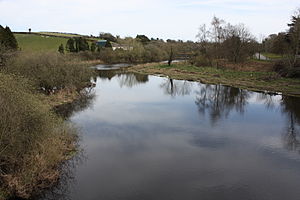Annacloy River: Difference between revisions
Created page with "right|thumb|250px|Annacloy River at Annacloy, September 2010 '''Annacloy River''' is a river in County Down which rises in..." |
m clean up, typos fixed: Dispite → Despite |
||
| Line 8: | Line 8: | ||
==River Quoile== | ==River Quoile== | ||
[[File:Quoile River, Downpatrick, April 2010 (01).JPG|right|thumb|300px|River Quoile, from Quoile Bridge, April 2010]] | [[File:Quoile River, Downpatrick, April 2010 (01).JPG|right|thumb|300px|River Quoile, from Quoile Bridge, April 2010]] | ||
The '''Quoile''' is the lower part of the Annacloy River, to its discharge into [[Strangford Lough]]. Its name is from the Irish language; ''An Caol'' meaning "The narrow". | The '''Quoile''' is the lower part of the Annacloy River, to its discharge into [[Strangford Lough]]. Its name is from the Irish language; ''An Caol'' meaning "The narrow". Despite an ancient name, the river is not ancient, but the result of 18th century land reclamation works constricting into a river a former arm of Strangford Lough. | ||
The Quoile flows through [[Downpatrick]] and the Quoile Pondage before finally emptying into [[Strangford Lough]]. | The Quoile flows through [[Downpatrick]] and the Quoile Pondage before finally emptying into [[Strangford Lough]]. | ||
Latest revision as of 12:16, 31 January 2016

Annacloy River is a river in County Down which rises in the Dromara Hills and flows into Strangford Lough.[1]
The Ballynahinch River, flowing east through Ballynahinch, and the Carson's Dam River, flowing south through Crossgar, join at Kilmore, and the united stream is called the Annacloy River, and lower down the River Quoile, falling into the southwest angle of Strangford Lough near Downpatrick.[2]
On the river between Mason's bridge and Kilmore there are regular and continuous rapids and weirs. Between Kilmore and Annacloy the river is quieter although there are still a couple of weirs. There are at least 2 dangerous weirs between Raleagh and Rademon. Below Annacloy the river calms down to Jane's Shore in Downpatrick. Canoeing is not at present permitted below Jane's Shore as entry to the Quoile Pondage National Nature Reserve is not permitted.[1] The river is generally known as the River Quoile from Annacloy down through Downpatrick to the Barrage where it flows into Strangford Lough.[3]
River Quoile

The Quoile is the lower part of the Annacloy River, to its discharge into Strangford Lough. Its name is from the Irish language; An Caol meaning "The narrow". Despite an ancient name, the river is not ancient, but the result of 18th century land reclamation works constricting into a river a former arm of Strangford Lough.
The Quoile flows through Downpatrick and the Quoile Pondage before finally emptying into Strangford Lough.
History
The Quoile was effectively created when Edward Southwell (1705–1755) landlord of Downpatrick built a tidal barrier at the Quoile and began draining the land, creating 500 acres of land from what was previously the western branch of Strangford Lough. The name comes from the narrowest point of the estuary at Finnebrogue, where a ford and ferry existed before the construction of the bridge. Harris, in 1744, mistakenly writes that the name of the bridge should be Coyne (after the branch of Loch Cuan up stream) not Coyle because he overlooked the origin.
In October 1991, during dredging operations in the river, a piece of oak, perhaps the remains of a log-boat, was found. Following dendrochronological dating it was found to have a Neolithic date of 2739 BC.[4]
Inch Abbey

On the north bank of the river, three-quarters of a mile northwest of Downpatrick, the Inch Abbey site was originally on an island (Inis) in the Quoile Marshes. The pre-Norman Celtic monastic settlement here, known as Inis Cumhscraigh (or Inis Cuscraidh),[5] was in existence by the year 800. In 1002 it was plundered by the Vikings led by Sitric,[6] King of the local Danes, who came up the Quoile with a fleet from the sea. The Vikings plundered the settlement again in 1149. The Cistercian Inch Abbey monastery, founded by John de Courcy in 1180, is located near to the river in the southern area of the Early Christian earthwork enclosure.[5]
Quoile Castle
Quoile Castle is a mile and a half from Downpatrick, just off the main road from Downpatrick to Strangford, on the east bank of the river. It is a 16th-century tower house which was inhabited into the 18th century.[7]
Quoile Pondage National Nature Reserve
The Quoile Pondage National Nature Reserve is situated just outside Downpatrick on either side of the Quoile River. It was created in 1957 by the construction of a tidal barrier to prevent flooding in the Downpatrick area. Soon after the barrier was built, plants and trees colonised the former seashore. Facilities at the reserve include the Quoile Countryside Centre with displays on the wildlife and history of the area. There are also many features of historical interest within the reserve including Quoile Quay situated close to the Centre, which itself is just beside Quoile Castle.[8]
Outside links
| ("Wikimedia Commons" has material about Annacloy River) |
| ("Wikimedia Commons" has material about iver Quoile) |
References
- ↑ 1.0 1.1 "Annacloy River". White Water - Canoe NI. Archived from the original on 26 February 2009. http://web.archive.org/web/20090226103828/http://canoeni.com/White_Water.aspx. Retrieved 27 February 2009.
- ↑ "Down - Atlas and Cyclopedia of Ireland (1900)". Library Ireland. http://www.libraryireland.com/Atlas/Down.php. Retrieved 27 February 2009.
- ↑ "Quoile Estuary". Flat Water - Canoe NI. http://www.canoeni.com/Flat_Water.aspx. Retrieved 27 February 2009.
- ↑ Donnelly, CJ (1997). Living Places. Belfast: Institute of Irish Studies, QUB. p. 50.
- ↑ 5.0 5.1 Donnelly, CJ (1997). Living Places. Belfast: Institute of Irish Studies, QUB. pp. 85–88.
- ↑ Government of Northern Ireland (1947). An Account of the Ancient Monuments in State Charge. Belfast: HMSO. pp. 26–27.
- ↑ Department of the Environment for Northern Ireland (1983). Historic Monuments of Northern Ireland. Belfast: HMSO. p. 107.
- ↑ "Quoile Countryside Centre". Environment and Heritage Service. http://www.ehsni.gov.uk/other-index/places/parks/quoile.htm. Retrieved 2008-06-06.
Coordinates: 54°20′46″N 5°46′30″W / 54.34615°N 5.77503°W
